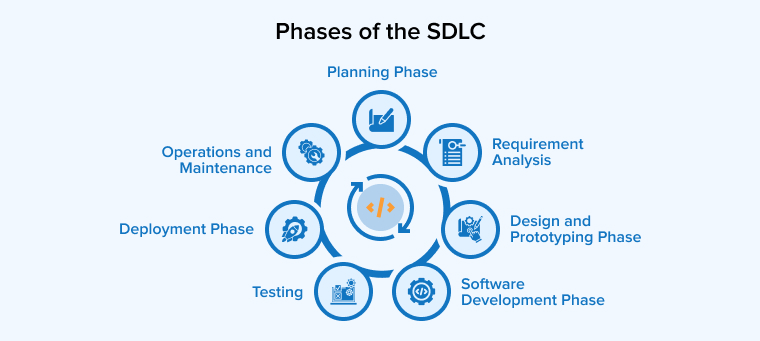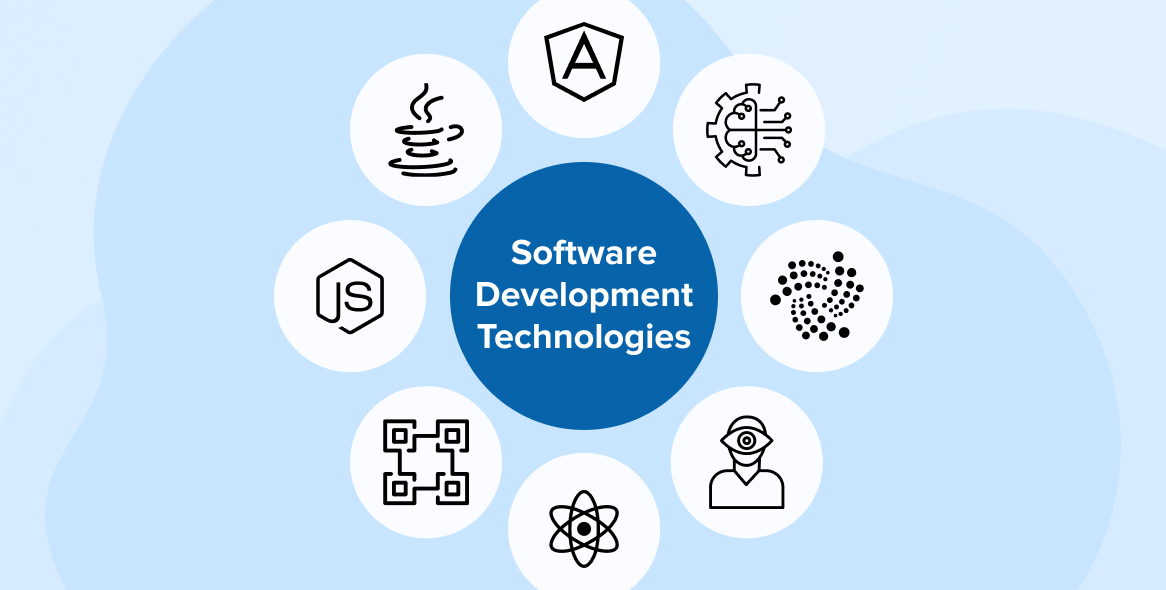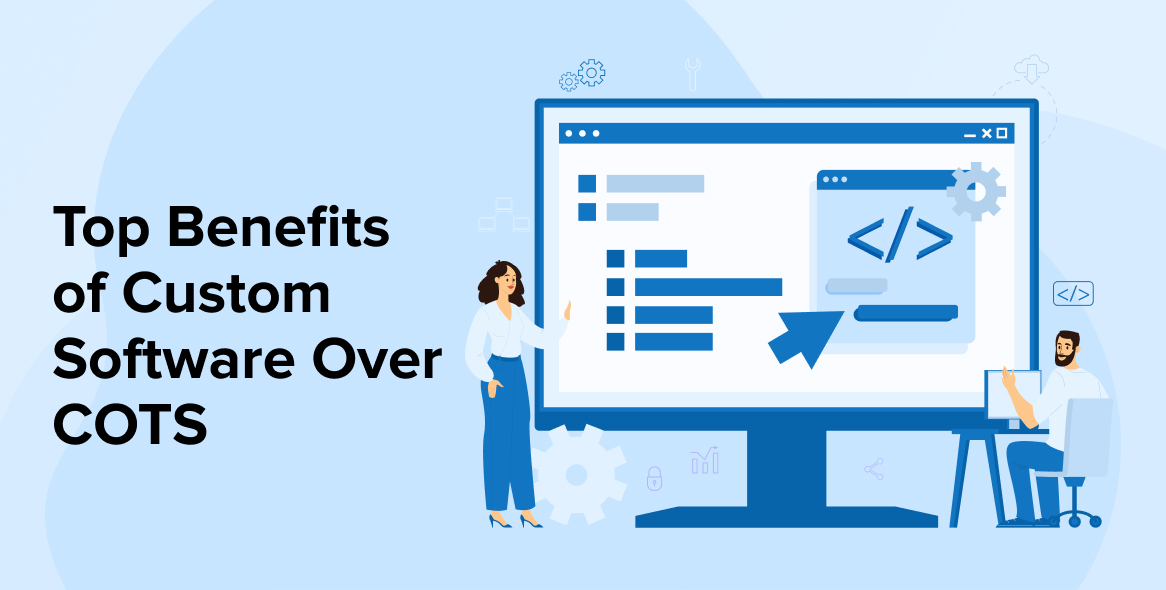
Software development life cycle is a process that involves stages like software planning, analysis, designing, development, testing, deployment, and maintenance of the application. By implementing the SDLC methodology, software development companies can ensure better-functioning and high-quality software. Besides this, the software development life cycle helps in optimizing the development strategy by dividing the goals of the main business goal into smaller parts that are easier to achieve.
Therefore, in this blog, we will first understand what is SDLC, how it works, and then go through its top 7 phases followed by the benefits and best practices of the custom software development lifecycle that are used to offer good quality software to the customers.
1. What is the Software Development Life Cycle?
Software Development Life Cycle (SDLC) is a standard practice used by software developers to develop software applications. This process is typically divided into six to eight steps which include Project Planning, Requirement Analysis, System Designing, Development, Documentation, System Testing, Deployment, and Maintenance. Some of these steps might get combined, split, or omitted as per project manager’s working approach and the project’s scope. These steps are known as the core components which are recommended for all types of software development projects. The reason behind it is that these steps help in measuring and improving the development process. This Quora user summarizes SLDC definition very well.
The software development life cycle is a process that enables a fine-grain analysis of all these steps of the SDLC process. And this helps software development companies in maximizing their efficiency at each and every stage. Besides this, with the increasing computing power, the demand for developers and software increases. In this case, companies must be able to deliver software faster, reduce labor and material costs, and exceed customer expectations.
Basically, the software development life cycle is a process that helps the development team to achieve all the goals related to the project by identifying inefficiencies and fixing them to run the software smoothly.
1.1 Benefits of the SDLC
Some of the major benefits that SDLC provides to development teams are –
1. Clear Goal Descriptions
When the developers are using the SDLC approach for creating the software, they are aware of the goals that are to be met and what deliverables are expected out of them from the very beginning. They also have a clear idea about the deadline of the project.
2. Clear Stage Progression
The developers working on the SDLC process for creating an application can’t move on to the next phase until they complete the prior one and get a clear go from the manager.
3. Proper Testing Before Installation
SDLC models come with an approach that asks for implementing checks and balances to ensure that the developed software is tested thoroughly before being installed in any other code source.
4. Member Flexibility
With the SDLC method as everything is well-structured and documented for the project which includes project goals and methodologies, new members can easily adapt and be included in the project.
5. No One Can Break the Project
SDLC process utilizes extensive guideline documents and paperwork which is a team effort. This means that losing any team members of the project will not jeopardize the software project’s timeline.
6. Perfection is Achievable
While working with SDLC, all the software development stages are meant to give feedback on one another. This means that the project can iterate and improve by itself if all the stages are carried out perfectly.
1.2 How Does the SDLC Work?
SDLC is a process that works by lowering development cost while shortening the production time and improving the software quality. This process is able to offer the best software development product by following a plan that eliminates all the typical pitfalls of the production environment. Here are the points which show how this plan works –
- The first step of the SDLC process is to evaluate the existing systems for deficiencies.
- Then, this agile model defines the requirements of the new system that is supposed to be built.
- After defining the requirements, the next step is to create the software by following different software development phases such as requirement analysis, project planning phase, designing, development, software testing, and deployment.
- The SDLC process also anticipates costly mistakes like not asking for client reviews and eliminates redundant rework.
- In the SDLC process, there is a strong focus on the software testing phase as this process follows a repetitive methodology which means that ensuring code quality at every stage is essential. There are some organizations that tend to spend little time on testing but results in rework and wastage of time.
Basically, SDLC is a simple yet important approach that every software company must follow while creating software for their clients. It offers a smooth software development process and saves a lot of time & money. It also helps in delivering software projects as per customer expectations.
Now, let’s have a look at the different phases of the Software Development Life Cycle.
2. Top Seven Phases of the SDLC

Here are the 7 phases of the software development lifecycle that every development team follows while creating software.
2.1 Planning Phase
This is the first phase of the SDLC. Before starting with this stage, the most important thing that any development team can do is take out time and get a proper understanding of the software development project. The first stage, the planning stage is also known as the feasibility stage. In this stage, the developers start planning the upcoming project which means that they decide how they will take this project and what approach will be followed throughout the development phase. This planning helps the developers to define the problem of the existing system if there is any and its scope. Besides, the objective of the new system that is supposed to be created is also determined.
In the software project plan, the software engineers sit together and create an effective outline for the development life cycle they are going to follow for the new project. They first theoretically catch all the problems before the development starts. This helps in securing the resources and funding that are needed to create the software. Besides this, the planning stage helps in scheduling the stages of the project development. This is very important if the developers are developing the commercial product that is to be sent to the market.
This shows that planning is a very important stage in the SDLC.
2.2 Requirement Analysis
After planning, comes the requirement analysis stage. Here the developers gather all the required details about the new system that is to be developed. The development team sits with the client and understands what the customer wants the team to create. The group tries to understand the new project’s needs and where it is going to be used. After all these things the first idea for prototype models is determined. This means that the developers may define the prototype of the system requirements, evaluate the alternative solutions, and perform research to determine the requirements of the client and the end-users.
Besides this, the development team also creates a software requirement specification (SRS) document which includes all the specifications for the project that needs to be developed, the hardware, software, and network requirements for the system. This approach helps the development team to prevent overdrawing resources and funding when working at the same place as other software development teams.
2.3 Design and Prototyping Phase
Once the requirements analysis is carried out and understood by the development team, the next step is to frame software architecture. In this stage the developers can start to design the software. For software designing, the team uses established patterns for software development and application architecture. The software development team uses proven design patterns that can help solve algorithmic problems. In this stage, besides creating design patterns as per the project scope and requirement, some rapid prototyping is also included which is called spike. This is done to compare the different design solutions and find out which suits best to that particular project as per its needs. In the designing and prototyping phase, the output includes designing documents that come with a list of patterns & components as per the project, and code developed by spikes is utilized as the initial point for the development
In this phase of the software development life cycle, central team roles included are – Software architect and UX/UX designers.
2.4 Software Development Phase
Once the software design is ready and then the development phase starts. The developers start creating the software project in this stage of the software development life cycle. Here the code is written for the product and put together by developers. For this, the software developers follow an Agile approach which is the most efficient and significant model for software development projects. The first development phase of SDLC is to create the MVP (minimum viable product). If the developers follow the Waterfall model approach, the anticipated finished product is documented in detail from start to end in the designing and prototyping phase. Then in the software development phase, the creation of the software starts.
In this software development phase of the software development lifecycle, the team roles included are – front-end & back-end developers and UX/UX designers.
2.5 Testing
During the software testing phase, the created software is tested against requirements defined in the planning and analysis phase. This testing is carried out to check the performance of the software, see if there are any bugs, and check that it works as per the client’s expectations. The main aim of this phase is to ensure that the software product is developed as intended and that both the user experience and the resources that are required for it to run efficiently and smoothly are available. This means that software testers see to it that the developed product meets security requirements and other availability. Besides this, software testing is a process that involves two types of testing, automated testing which is based on scripts & tools, and manual testing which is carried out by engineers manually.
While carrying out any type of software testing method, if any defects or bugs are found then the tester documents the entire issue and informs the developers from the team who were involved in creating the software and ask them to resolve the issues. After the issues are resolved, the testers again go through the entire software and check the system again in case of any updates or unintended consequences. If bugs are found, the developers will have to work on it again. This is a long process and this is why many software development companies use the DevOps approach which enables the development and testing phases to be carried out together by tightly integrating the development phase with the testing phase on a continuous basis.
In this software testing phase of the software development lifecycle, the central team roles involved are – QA engineers, solution architects, testers, and DevOps engineers.
2.6 Deployment Phase
After the product is thoroughly tested and bugs are cleared by the development team, the software goes to the deployment phase. Here the software application is moved from its development and testing phases into a live environment where the users can start using it or working on it. The deployment phase is a relatively simple process compared to all other processes of the SDLC model. For instance, if the newly developed software application comes with a database that will be used by other systems, then integrating all the other systems into the newly created product is a significant time taking and difficult process. In such cases the deployment phase might be difficult.
Besides this, when it comes to the software deployment process, the most crucial moment is to make sure that the software works the same way in the live environment as it was working while it was being developed. For this, live testing is carried out in the deployment phase. When the team of developers is working on DevOps CI/CD software development method, there is pre-deployment and live, two phases. Here, the pre-deployment software must be identical to the live one. The live software must be able to minimize the risk of discrepancies in how the software runs in the live environment.
In the deployment phase of the software development lifecycle, the most important team roles are database administrator and DevOps engineer.
2.7 Operations and Maintenance
The last phase after the deployment is maintenance. This phase means that the development team must make sure that the software application that has been delivered continues to run properly as it is intended to in terms of availability, performance, and functionalities. If the users or the ongoing testing team finds any type of bugs or defects or security breaches, then they must be immediately resolved so that the business of the client doesn’t suffer. Basically, in the operations and maintenance phase, the software development team must offer after-deployment support and keep a close watch on how the software works.
In the operations and maintenance phase of the software development lifecycle, the main roles included are – testers, support managers, and users.
3. Best Practices of SLDC
Here are the top practices of the software development life cycle –
3.1 Source Control
Source Control is one of the best practices of SDLC. It is a security plan to secure the code that developers are working on. Here source control is implemented by keeping the code of the application at a single location and securing its access. This location can be a physical one where the files of the project are stored and can be accessed in a single room of the software development company’s building. Besides, it can also be a virtual space where the users or high-level developers and project managers can log in with an encrypted connection. This virtual place could be a cloud-based development environment.
Basically, Source Control software applications include a new management approach to track work done by teams or individuals while developing software.
3.2 Continuous Integration
Continuous Integration is another SDLC practice that makes sure that each and every component of the software is compatible throughout the entire development cycle. Before the Continuous Integration concept came into the market, different teams were creating their own projects independently. It creates significant challenges especially if any of the developers stitched the application together.
Take a look at this tweet it perfectly explains continuous integration in a crisp manner.
The continuous integration/continuous delivery (CI/CD) pipeline process builds, tests, and deploys codes by using automation and works with the power of the cloud.
— IBM Cloud (@IBMcloud) January 13, 2022
Get the details: https://t.co/MH7LBGB0eV pic.twitter.com/FooxEvMzd1
Basically, Continuous Integration ensures all teams use similar libraries and programming languages. This approach will eventually help avoid all the conflicts and duplication of work.
3.3 SDLC Management Systems
Software development lifecycle management system works to manage and control each & every step of the SDLC. This means that the system adds transparency to each phase of the project which helps the entire software development team see what work is going on and what has been completed. The management systems also add bug-tracking, analytics, and work management systems.
4. Conclusion
As seen in this software development lifecycle blog, the software development process begins as a concept and progresses through various different phases until release in the live environment. All the stages the development process goes through can be as per the SDLC best practices. It helps the developers to create an application smoothly and efficiently. With this process the developers can come up with the software as per the client’s expectations and it can be developed using any of the software development methodologies like agile or waterfall. Basically, the SDLC approach enables easy creation of the project, offers flexibility to the team , and saves software development time. This is why, in the software development ecosystem, there is no perfect method other than SDLC.






This article will help you understand the lifecycle of software development. The author explains every stage in a very well manner. By applying best practices and techniques, the software development life cycle is a great procedure that may assist teams through the process of producing and releasing software, including any necessary fixes.
Even for someone like myself who doesn't understand technology, this article clearly stated and simple to grasp. I appreciate how the stages of the SDLC were thoroughly explained, as well as how they interact to produce successful software development. Additionally useful were the advantages and best practices of the SDLC, particularly for individuals who are new to software development.
This blog post on the software development life cycle (SDLC) is incredibly interesting to read and it is very interactive. The information was quite thorough and instructive, in my opinion. I really valued the section on the various SDLC models since it helped me better grasp the various ways that may be used in software development.